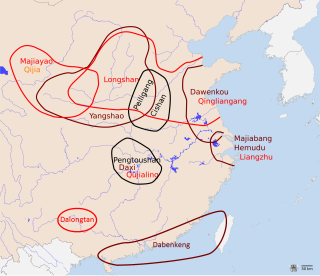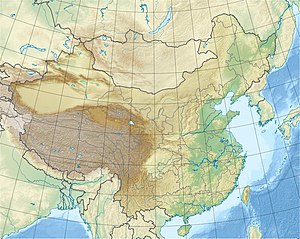During the 40th century BC, the Eastern Mediterranean region was in the Chalcolithic period, transitional between the Stone and the Bronze Ages. Northwestern Europe was in the Neolithic. China was dominated by the Neolithic Yangshao culture. The Americas were in a phase of transition between the Paleo-Indian (Lithic) to the Meso-Indian (Archaic) stage. This century started in 4000 BC and ended in 3901 BC.

The Yangshao culture was a Neolithic culture that existed extensively along the middle reaches of the Yellow River in China from around 5000 BC to 3000 BC. The culture is named after the Yangshao site, the first excavated site of this culture, which was discovered in 1921 in the town of Yangshao in western Henan by the Swedish geologist Johan Gunnar Andersson (1874–1960). The culture flourished mainly in Henan, as well as the neighboring provinces of Shaanxi and Shanxi.

The Longshanculture, also sometimes referred to as the Black Pottery Culture, was a late Neolithic culture in the middle and lower Yellow River valley areas of northern China from about 3000 to 1900 BC. The first archaeological find of this culture took place at the Chengziya Archaeological Site in 1928, with the first excavations in 1930 and 1931. The culture is named after the nearby modern town of Longshan in Zhangqiu, Shandong. The culture was noted for its highly polished black pottery. The population expanded dramatically during the 3rd millennium BC, with many settlements having rammed earth walls. It decreased in most areas around 2000 BC until the central area evolved into the Bronze Age Erlitou culture. The Longshan culture has been linked to the early Sinitic . According to the area and cultural type, the Longshan culture can be divided into two types: Shandong Longshan and Henan Longshan. Among them, Shandong Longshan Cultural Site includes Chengziya Site; Henan Longshan Cultural Site includes Dengfeng Wangchenggang Site in Wangwan, Taosi Site and Mengzhuang Site in Hougang.
In archaeology, a type site is the site used to define a particular archaeological culture or other typological unit, which is often named after it. For example, discoveries at La Tène and Hallstatt led scholars to divide the European Iron Age into the La Tène culture and Hallstatt culture, named after their respective type sites.

The Dawenkou culture was a Chinese Neolithic culture primarily located in the eastern province of Shandong, but also appearing in Anhui, Henan and Jiangsu. The culture existed from 4300 to 2600 BC, and co-existed with the Yangshao culture. Turquoise, jade and ivory artefacts are commonly found at Dawenkou sites. The earliest examples of alligator drums appear at Dawenkou sites. Neolithic signs, perhaps related to subsequent scripts, such as those of the Shang dynasty, have been found on Dawenkou pottery. Additionally, the Dawenkou practiced dental ablation and cranial deformation, practices that disappeared in China by the Chinese Bronze Age.

The Majiayao culture was a group of neolithic communities who lived primarily in the upper Yellow River region in eastern Gansu, eastern Qinghai and northern Sichuan, China. The culture existed from 3300 to 2000 BC. The Majiayao culture represents the first time that the upper Yellow River region was widely occupied by agricultural communities and it is famous for its painted pottery, which is regarded as a peak of pottery manufacturing at that time.
The Afanasievo culture, or Afanasevo culture, is an early archaeological culture of south Siberia, occupying the Minusinsk Basin and the Altai Mountains during the eneolithic era, c. 3300 to 2500 BCE. It is named after a nearby mountain, Gora Afanasieva in what is now Bogradsky District, Khakassia, Russia, first excavated by archaeologist Sergei Teploukhov in 1920-1929. Afanasievo burials have been found as far as Shatar Chuluu in central Mongolia, confirming a further expansion about 1,500 km beyond the Altai Mountains. The Afanasievo culture is now considered as an integral part of the Prehistory of Western and Central Mongolia.

The Hemudu culture was a Neolithic culture that flourished just south of the Hangzhou Bay in Jiangnan in modern Yuyao, Zhejiang, China. The culture may be divided into early and late phases, before and after 4000 BC respectively. The site at Hemudu, 22 km northwest of Ningbo, was discovered in 1973. Hemudu sites were also discovered at Tianluoshan in Yuyao city, and on the islands of Zhoushan. Hemudu are said to have differed physically from inhabitants of the Yellow River sites to the north. Some authors propose that the Hemudu Culture was a source of the pre-Austronesian cultures.

The Qijia culture was an early Bronze Age culture distributed around the upper Yellow River region of Gansu and eastern Qinghai, China. It is regarded as one of the earliest bronze cultures in China.

The Pengtoushan culture was a Neolithic culture located around the central Yangtze River region in northwestern Hunan province, China. It dates to around 7500–6100 BC, and was roughly contemporaneous with the Peiligang culture to the north. It is named after the type site at Pengtoushan.

The Shijiahe culture was a late Neolithic culture centered on the middle Yangtze River region in Shijiahe Town, Tianmen, Hubei Province, China. It succeeded the Qujialing culture in the same region and inherited its unique artefact of painted spindle whorls. Pottery figurines and distinct jade worked with advanced techniques were also common to the culture.

The Dadiwan culture was a Neolithic culture located primarily in the eastern portion of Gansu and Shaanxi provinces in modern China. The culture takes its name from the deepest cultural layer found during the original excavation of the type site at Dadiwan. The remains of millet, pigs and dogs have been found in sites associated with the culture, which is itself defined by a thin-walled, cord-marked ceramic tradition sometimes referred to as Laoguantai. The Dadiwan culture shares a variety of common features, in pottery, architecture, and economy, with the Cishan and Peiligang cultures to the east.

Banshan was a phase of the Chinese Neolithic Majiayao culture, c. 2600 to 2300 BC. The Banshan site is in Guanghe County, Gansu.
Beginning in the latter half of the 20th century, artifacts bearing markings dating to the Neolithic period have been unearthed at several archeological sites in China, mostly in the Yellow River valley. These symbols have been compared to the oracle bone script—the earliest known forms of Chinese characters, first attested c. 1200 BCE—and have been cited by some as evidence that Chinese writing has existed in some form for over six millennia. However, the Neolithic symbols have only been found in small numbers, and do not appear to go beyond pictorial techniques, as is required to obtain a true writing system representing spoken language.

Jiangzhai is a Banpo phase Yangshao culture archaeological site in the east of Xi'an, where the earliest copper artifacts in China were found.
Okunev culture, also known as Okunevo culture, was a south Siberian archaeological culture of pastoralists from the early Bronze Age dated from the end of the 3rd millennium BC to the early 2nd millennium BC in the Minusinsk Basin on the middle and upper Yenisei. It was formed from the local Neolithic Siberian forest cultures, who also showed evidence of admixture from Western Steppe Herders and pre-existing Ancient North Eurasians.

In 2001, the Institute of Archaeology of the Chinese Academy of Social Sciences organized a poll for China's 100 major archaeological discoveries in the 20th century. The participants included eight national-level institutions for archaeology and cultural relics, provincial-level archaeological institutes from 28 provinces, municipalities, and autonomous regions, as well as from Hong Kong, the archaeological departments of 11 major national universities, and many other scholars in Beijing. After three months and three rounds of voting, the results were announced on 29 March 2001 and were published in the journal Kaogu (Archaeology). In 2002, the Chinese Academy of Social Sciences Press published the book China's 100 Major Archaeological Discoveries in the 20th Century (二十世纪中国百项考古大发现), with more than 500 pages and 1,512 pictures.
The earliest human occupation of what is now China dates to the Lower Paleolithic c. 1.7 million years ago—attested by archaeological finds such as the Yuanmou Man. The Erlitou and Erligang cultures inhabiting the Yellow River valley were Bronze Age civilizations predating the historical record—which first emerges c. 1250 – c. 1200 BCE at Yinxu, during the Late Shang.

The Baijia culture (Ch:百家文化) is an ancient Neolithic culture of China, dated to 5800-5000 BCE. It is considered as the earliest Chinese culture to make painted pottery. The pottery was sometimes painted in simple red.

























